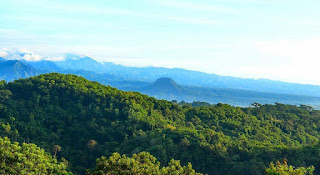TALES OF WAR
The author (center) with Hirohide Yano & his son
It was a typical cold January morning when I observed two Japanese gentlemen quietly sitting in the dining area of my Duyan House bed and breakfast at the Sinagtala Farm Resort in Orani, Bataan. One was a bespectacled distinguished looking elderly man and the other a young man that I immediately surmised to be the son.
As is my habit, I approached their table and asked where they were from and what brought them to the mountains of Orani, Bataan.
The elderly gentlemen(Hirohide Yano) I leanrt is presently the president of a regional bank in Japan which coincidentally is a correspondent bank of Philippine National Bank. His bank is used by the Filipinos in his community to send remittances to the Philippines.
After the usual exchange of names and handshakes, I learned that Hirohide and his son were in the mountains of Orani to visit the site where the father of Hirohide, who was a lieutenant in the Japanese army during the second world war, met his death. Apparently, the lieutenant died in an encounter with Filipino forces at the bank of a river located in a baranggay near the resort. I also found out that Hirohide now 77 years old was newly born when his father was called to arms to fight for the Japanese empire.
But this is not all...the Lieutenant’s son and grandson had been in Luzon for almost two weeks prior to our meeting, tracing the footsteps of the Lieutenant from the time he landed in Pangasinan to his death in Bataan. Thus, they had already been to Lingayen where the Japanese forces first landed when they invaded the Philippines. They also visited the Capas concentration/death camp and the Japanese airfield thereat where Kamikaze suicide mission pilots first trained and flew out in a desperate effort to turn the tides of war.
Amazingly, my guests were armed with maps and books to guide them on their travel and to follow from the books they read and carried, the narrative of the battle to give them a personal sense of the experience the lieutenant and his comrades underwent during those frenzied times.
With their backpacks , father and son moved around from Lingayen to Pampanga and to Bataan in public transport and tricycles staying in inns and hotel to get the pulse of the community. Hiking and trekking the countryside of Orani, Bataan they wanted get a feel of the battlefield terrain and walk the path the Lieutenant took, leading to his ultimate sacrifice for his fatherland.
I imagine that hunger and thirst were the cause of the riverside encounter in Orani Bataan. Thirsty, hungry and desperate, the opposing forces encountered each other while both were searching for food and water to survive the day. It was indeed tragic that death a resulted in the Lieutenants desire to survive.
The exact place of the encounter was marked in a map Hirohide was carrying. They even know that the encounter took place at the back of a school which did not exist when the event happened.
According to Hirohide, they did an extensive research on the incident on top of reading many books and articles about the battle of Bataan, the death march and the Capas concentration camp.
Orani town, from the waters of Manila Bay through the mountains of Bataan up to South China Sea, was the second line of defence established by the Americans to repel the invading Japanese forces. The first line of defence was the Tama River in Dinalupihan town extending from Manila Bay to the mountains of Subic, Zambales. When the Orani line fell , the forces defending Bataan retreated to the final Pilar/Bagac line. It was all for naught as the American/ Filipino forces surrendered in Mariveles Bataan on April 9 1942.
January 30 2019, when the picture was taken, was a sad day for Hirohide and his son as that was the day the Lieutenant died 76 years ago.
As a postscript, the actual heavy land assault against the Bataan defenders started during the Holy week of 1942.
Probably third or last week of March. If the Lieutenant died on Jan 30,1942 he had to be in the Japanese advance force possibly studying the terrain and the defensive positions of the opposing forces preparatory to the Holy Week assault.
Be that as it may, the journey through life of the Lieutenant, his son, Hirohide and his grandson, tells us that there are no victors in war and that time is the best healer. Enemies then , now friends , this Japanese-Filipino story is not unique . For anyone who experienced suffering during that period , they have our own stories tell and with the telling, hopefully time would have healed and softened the hurt and sadness.
Ding Pascual
February 1, 2019
The Duyan House



Comments
Post a Comment